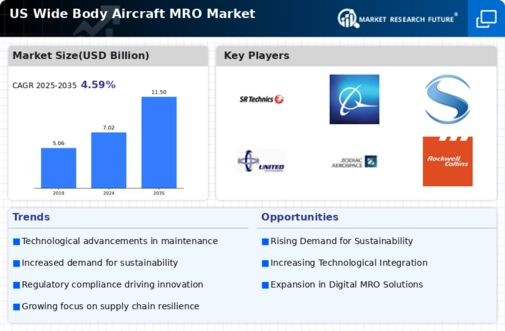Rising Maintenance Costs
Rising maintenance costs are a critical driver for the wide body-aircraft-mro market. As aircraft technology becomes more sophisticated, the complexity of maintenance procedures increases, leading to higher costs for airlines. The FAA indicates that maintenance expenses can account for up to 10% of an airline's operating costs. This financial pressure compels airlines to seek efficient MRO solutions that can help manage costs while ensuring compliance with safety regulations. Consequently, the wide body-aircraft-mro market is likely to see increased demand for cost-effective maintenance solutions, including predictive maintenance technologies and streamlined repair processes, as airlines strive to optimize their operational expenditures.
Increasing Air Travel Demand
The wide body-aircraft-mro market is experiencing a surge in demand driven by the increasing air travel demand in the United States. As more passengers opt for air travel, airlines are expanding their fleets, particularly with wide body aircraft, to accommodate this growth. According to the Federal Aviation Administration (FAA), passenger traffic is projected to grow by approximately 3.5% annually over the next decade. This growth necessitates a corresponding increase in maintenance, repair, and overhaul services for wide body aircraft, as airlines seek to ensure safety and reliability. Consequently, to ensure operational efficiency and comply with regulatory standards..
Increased Regulatory Scrutiny
Increased regulatory scrutiny is a significant factor impacting the wide body-aircraft-mro market. Regulatory bodies in the United States, such as the FAA, are continuously updating safety and maintenance standards to ensure the highest levels of safety in air travel. This heightened scrutiny necessitates that airlines and MRO providers adhere to stringent compliance requirements, which can drive up the demand for specialized MRO services. As airlines strive to meet these evolving regulations, the wide body-aircraft-mro market is likely to see an uptick in demand for comprehensive maintenance solutions that ensure compliance and enhance safety protocols. This trend underscores the importance of maintaining rigorous standards in the maintenance of wide body aircraft.
Fleet Modernization Initiatives
Fleet modernization initiatives are significantly influencing the wide body-aircraft-mro market. Airlines in the United States are increasingly investing in newer, more fuel-efficient wide body aircraft to reduce operational costs and enhance performance. The FAA reports that the average age of commercial aircraft is declining, with many airlines opting to retire older models in favor of advanced technology aircraft. This shift not only improves fuel efficiency but also necessitates specialized MRO services tailored to the latest aircraft technologies. As a result, the wide body-aircraft-mro market is poised for growth, as MRO providers adapt to the evolving needs of modern fleets and offer innovative solutions to maintain these advanced aircraft.
Technological Integration in MRO Processes
Technological integration in MRO processes is reshaping the landscape of the wide body-aircraft-mro market. The adoption of advanced technologies such as artificial intelligence, big data analytics, and the Internet of Things (IoT) is enhancing the efficiency and effectiveness of maintenance operations. These technologies enable predictive maintenance, which allows airlines to anticipate potential issues before they arise, thereby reducing downtime and maintenance costs. The wide body-aircraft-mro market is likely to benefit from this trend, as MRO providers invest in technology-driven solutions to improve service delivery and operational efficiency. This integration not only enhances safety but also aligns with the industry's push towards modernization and innovation.

















Leave a Comment